Style is typically defined as “a particular, distinctive, or characteristic mode of action”. However, in the
investment world, style is the method or philosophy adopted by a fund manager in selecting investments for a strategy’s portfolio. Investment style is a key beacon in assisting investors to apportion expectations around the risk and performance prospects of a strategy.
It is incredibly important for an investor to understand the characteristics of an active fund manager’s
investment style. However, many investors find the styles of various managers difficult to identify. Morningstar’s research reports contain a simple and easy method for investors to assess a strategy’s investment style—the equity Morningstar Style Box (which is located at the bottom of the front page on
all Morningstar Manager Research reports).
Morningstar Style Box
The style box (Exhibit 1) indicates a strategy’s style based on a fund’s underlying portfolio holdings
(stocks) at a given point in time. It is a nine-square grid that has three style categories (value, blend, and growth) on the horizontal axis and three market-cap levels (small, mid, and large) on the vertical axis.
The blue centroid represents the strategy’s portfolio, the orange centroid the Morningstar Category average (Australia large value), and the red centroid the category index (S&P/ASX 200 Total Return). It is important for investors to understand that the style box represents only a given point in time, based on Morningstar’s classification of stocks. For a more detailed analysis, Morningstar Direct users can access a strategy’s holdings-based style trails, which shows the historical style movement of a fund
over a set time.
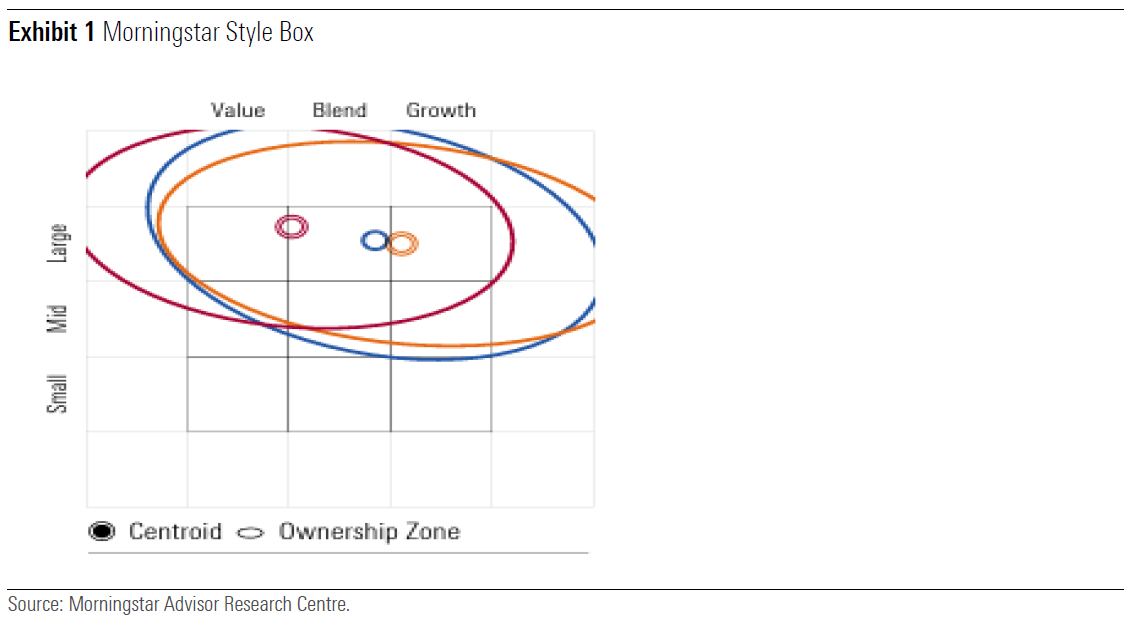
Value Investing
A value investment style is typically described in equity markets as investing in companies with stable
mature businesses, low debt levels, and solid cash flows that are trading on a low price/earnings ratio.
These stocks are normally undervalued or underappreciated by the market.
The Lazard Australian equities team is well-known in the market for its disciplined value approach to
selecting stocks and constructing portfolios. Lazard seeks companies that are “trading at a discount
relative to their intrinsic value” using fundamental research and modelling. This active value approach is strongly on display in the portfolio for Lazard Select Australian Equity Fund 10702, which has a Morningstar Analyst Rating of Bronze. The style box (Exhibit 2) indicates Lazard’s portfolio is firmly placed in the value region. However, it also suggests the portfolio holds marginally smaller large caps than most Morningstar Category peers.
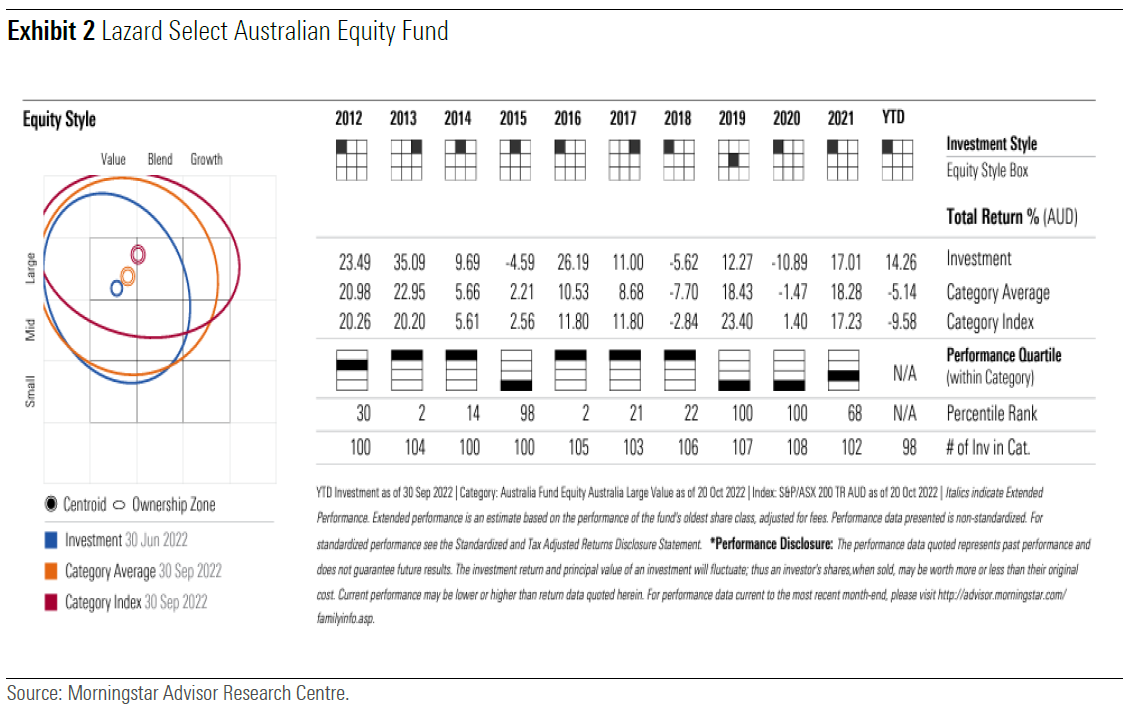
Undoubtedly, in the Australian market, Investors Mutual, or IML, is among the best-known value investment firms, having been established by Anton Tagliaferro in 1998. IML’s investment philosophy is based on the premise that “a company’s share price will reflect its underlying value over the long-term”, despite markets not being fully efficient. IML’s long-term conservative value investment style is
incorporated into the Gold-rated Investors Mutual Australian Share Fund 5339. However, the strategy’s style box (Exhibit 3) shows that the current IML portfolio has slipped slightly into blend (but very close to value), with most Morningstar Category peers further into the value space.
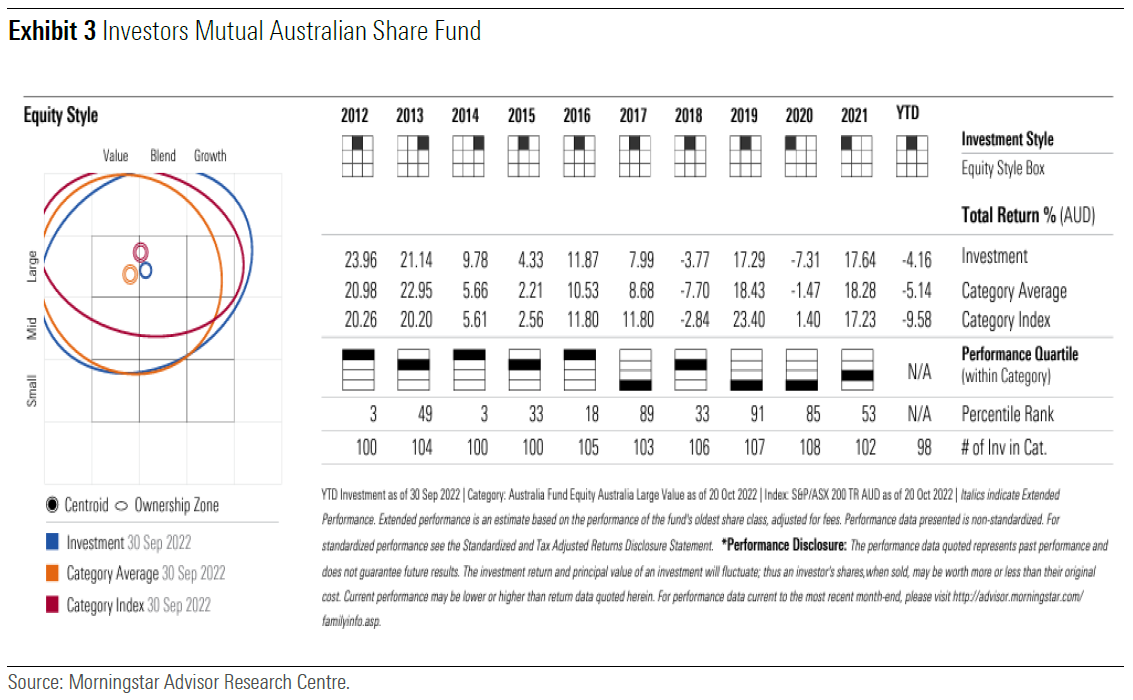
Growth Investing
Growth investing, or a growth investment style, is normally referred to in equity markets as investing in
companies with favourable characteristics and experiencing above-average growth compared with the
market. These are often less-mature companies and may appear very expensive under a traditional
valuation methodology (such as price/earnings ratio).
Hyperion is a well-respected Brisbane-based fund manager, established in 1996, which adopts a growth investment style. The firm defines its investment philosophy as “high quality, structural growth style”. Hyperion believes that truly exceptional structural growth companies are often underrecognised and undervalued by the market but are typically more resilient in adverse markets. This growth philosophy is exhibited in the stock selection for the Silver-rated Hyperion Australian Growth Companies Fund 3344.
The Hyperion style box (Exhibit 4) is interesting, as the portfolio is deeply into the growth region but also investing in smaller large-cap stocks than most Morningstar Category peers.
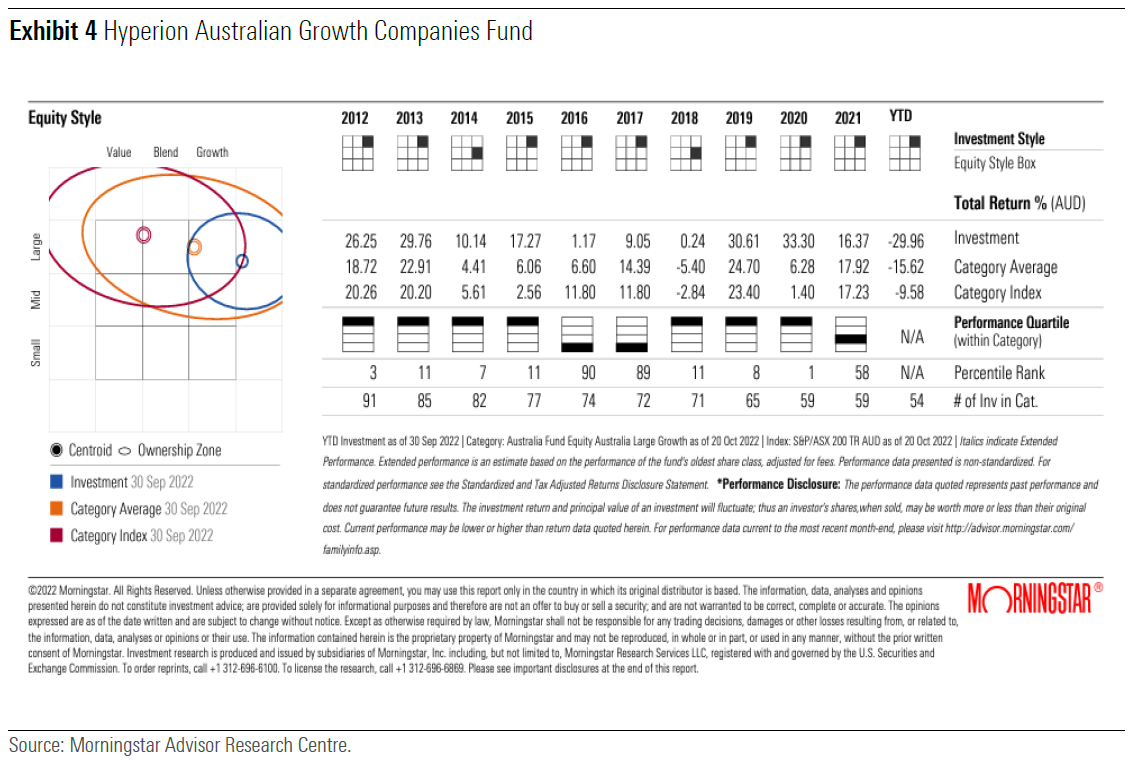
The First Sentier Investors, or FSI, Australian Equities Growth team, led by Dushko Bajic, adopts a growth investment style in a search for stocks to include in its Bronze-rated FSI Australian Share 3404 strategy. FSI’s investment approach is to seek “growing companies that generate consistent returns and can reinvest above their cost of capital”. The FSI style box (Exhibit 5) shows the portfolio currently very close to the growth region, but just in blend, with most Morningstar Category peers further into the growth space.

Blend Investing
A blend investing style is largely as it sounds, a combination of both the value and growth approach to
investment. The blend investment managers aim to build a balanced portfolio that will perform through the full economic cycle. A blend portfolio will contain value and growth stocks. The concept behind a blend portfolio is that it incorporates the best stocks from both the value and growth investment philosophy and is more diversified than either single approach.
The Pendal Australian equities team, under head of equities Crispin Murray, adopts a blend investment
style. The team seeks to identify factors that can change the level and quality of a company’s earnings,
evaluating aspects including industry structure, cyclical trends, business innovation, capital allocation,
and strategic growth plans. Pendal believes this approach will allow the portfolio to outperform through the cycle. Pendal utilises a large team of analysts to undertake fundamental bottom-up proprietary company research to select stocks for incorporation into the Gold-rated Pendal Australian Share Fund 2726. The style box (Exhibit 6) indicates that, in terms of style, Pendal’s portfolio is split between blend and value at this time, but with slightly larger large-cap stocks, on average, than most category peers.
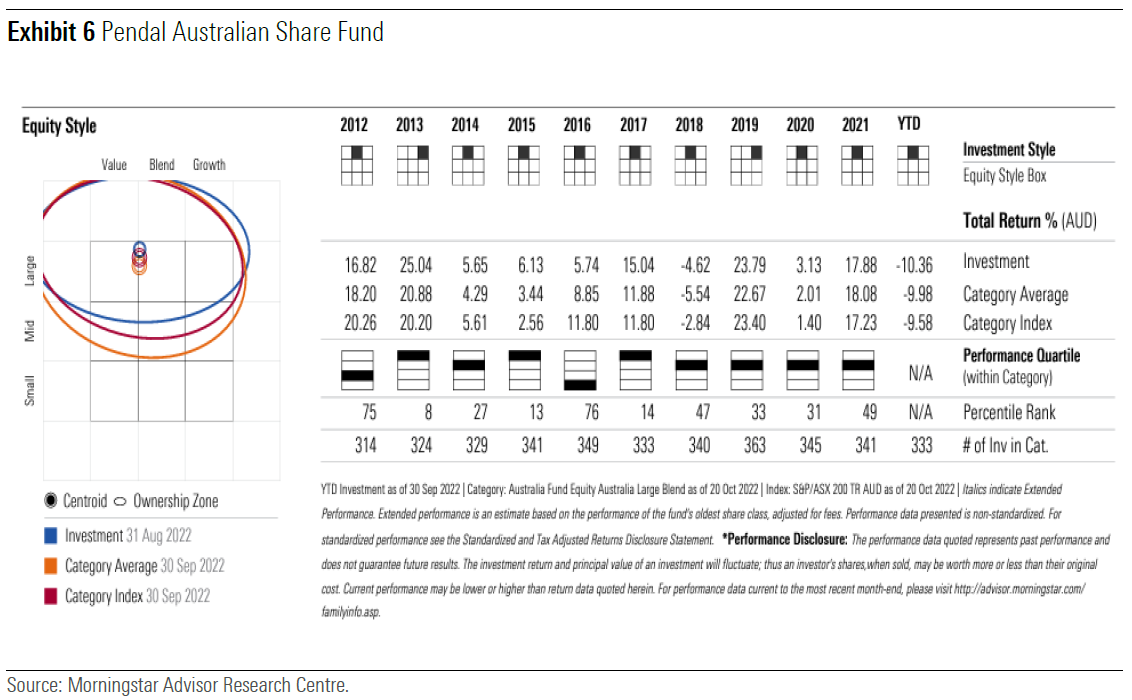
The Alphinity Australian equities team also adopts a blend investment style, seeking quality undervalued companies just commencing a maintainable earnings upgrade cycle. The team believes earnings drive share prices and earnings are serially correlated. To find companies with underestimated earnings growth, Alphinity adopts a differentiated multifaceted investment process that combines proprietary quantitative and qualitative research. The blended portfolio characteristics are solidly on display in the Bronze-rated Alphinity Australian Share Fund 3566. Like Pendal, the style box (Exhibit 7) for Alphinity’s portfolio indicates that, in terms of style, Alphinity’s portfolio is currently split between blend and value but with larger large-cap stocks than most category peers.
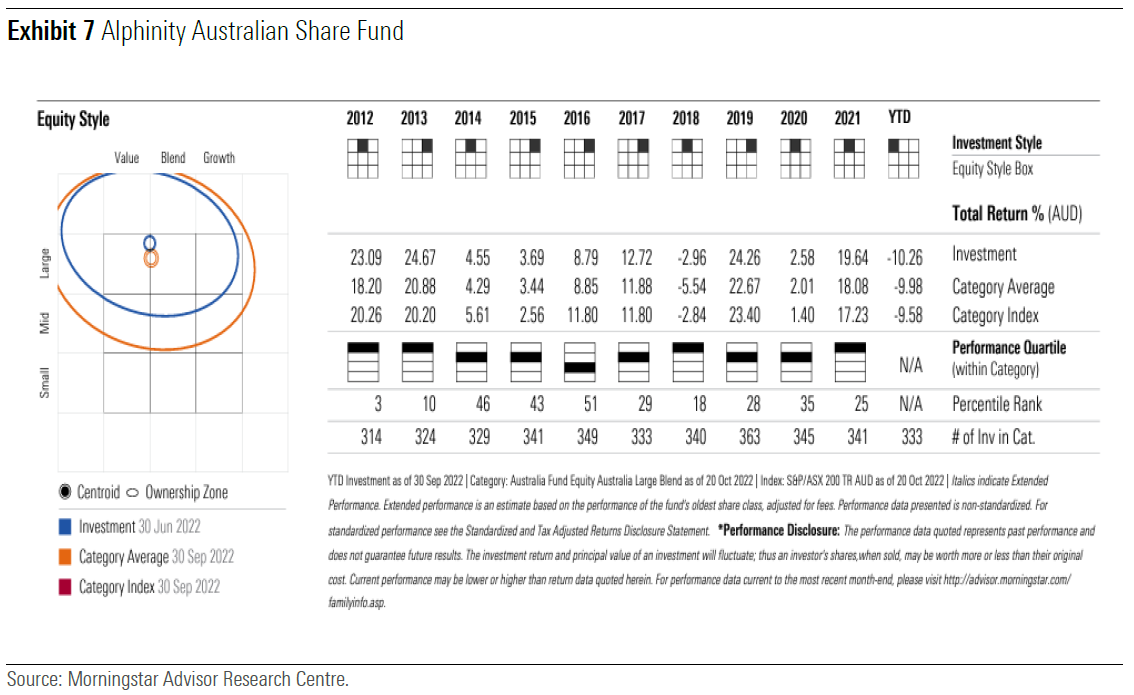
Style Winners: Value Investing Shines in 2022 but Longer-Term Growth Investing Leads Rising inflation, an interest-rate-tightening cycle, and concerns about a possible recession are weighing on the share market and are the perfect elements for the rotation to value stocks (mature businesses with pricing power, balance sheet strength, and positive cash flow). These conditions are placing considerable pressure on the S&P/ASX 200 Accumulation Index, which is down 9.6% in the nine months to 30 September 2022. Therefore, it is unsurprising that, since the start of the calendar year, active equity strategies with a value orientation have been outperforming the broader market (refer Table 8).
The average Australian equity value Morningstar Category strategy is down just 5.1% in the nine months to 30 September 2022 (compared with the S&P/ASX 200 Total Return). However, the standout performer is the Lazard Select Australian Equity Fund 10702, which is up a massive 14.3%. This strategy does not just adopt a value investing approach but is a concentrated high-conviction fund. Other value fund managers performing strongly in the current market conditions are Perpetual, Investors Mutual, Allan Gray, and Tyndall.
The performance of the growth fund managers is largely what you would anticipate given their investment style. The average Australian equity Growth Morningstar Category strategy is down 15.6% in the nine months to 30 September 2022. But the growth fund managers have experienced wonderful economic conditions during the years prior to mid-2021, with minimal inflation, low interest rates, and expansionary fiscal policies in place. However, the best performing growth category strategy is Ausbil Australian Active Equity 6117, which is down 7.2% for the nine months to 30 September 2022, followed by the Greencap Broadcap Fund 14654, which is down 14.2%.
The average Australian equity blend Morningstar Category strategy is down 10.0% in the nine months to 30 September 2022, just marginally behind the index. However, the best of the active blend strategies is the Solaris Australian Equity Long Short Fund 41829, down 3.9%, followed by the DNR Capital Australian Equity High Conviction Fund 40948, which was down 4.7%.
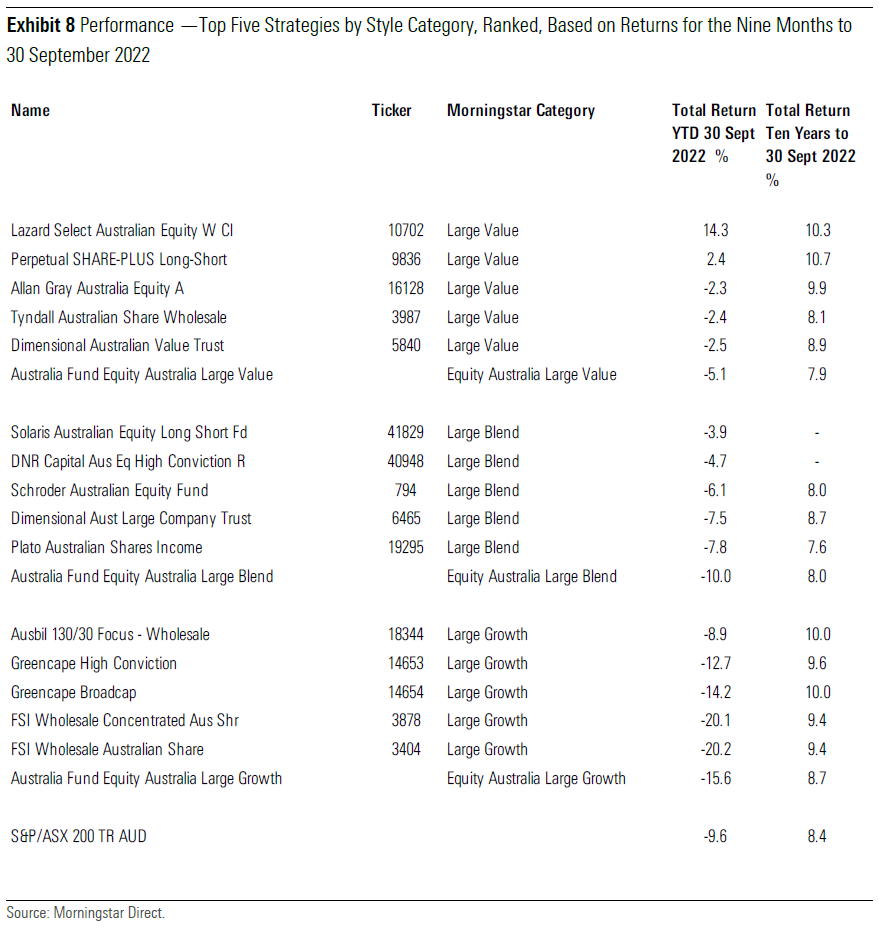
However, when investing, it is perilous to rely on just a one-year view. Long-term performance, through the economic cycle and geopolitical shocks, should be one of the many factors considered before investing in an Australian equity strategy. In the 10 years to 30 September 2022, the S&P/ASX 200 Accumulation Index was up 8.4% on an annualised basis. However, in the decade to 30 September
2022, the best performing strategies across all investment style categories reviewed by Morningstar were two growth-oriented funds (refer Table 9). The Bennelong Australian Equities Fund 16998 was up 11.1%, and the Hyperion Australian Growth Companies Fund 3344 was also up 11.1%, outperforming the index and most growth category peers.
The best performing value style strategies in the past decade also outperformed the index and most
category peers. The strategies were the Perpetual SHARE-Plus Long-Short Fund 9836, which was up 10.7% in the 10 years to 30 September 2022, followed by the Lazard Select Australian Equity Fund 1070, which was up 10.3%.
In the blend category, concentrated high-conviction strategies dominated, with the best performing blend style strategies in the past decade outperforming the index and most category peers. The outperforming strategies included the Pendal Focus Australian Share Fund 12910, the concentrated sibling of the Pendal Australian Share Fund, which was up 10.1% for the decade. In addition, the Alphinity Concentrated Australia Share Fund 12177, and Platypus Australian Equities Fund 14369, were both up 9.9%.
For investors, the best course of action is to select a fund manager who rigorously maintains the same investment style (value, growth, or blend) over the long term for researching, selecting stocks, and constructing a portfolio, despite the changing economic conditions or geopolitical events.
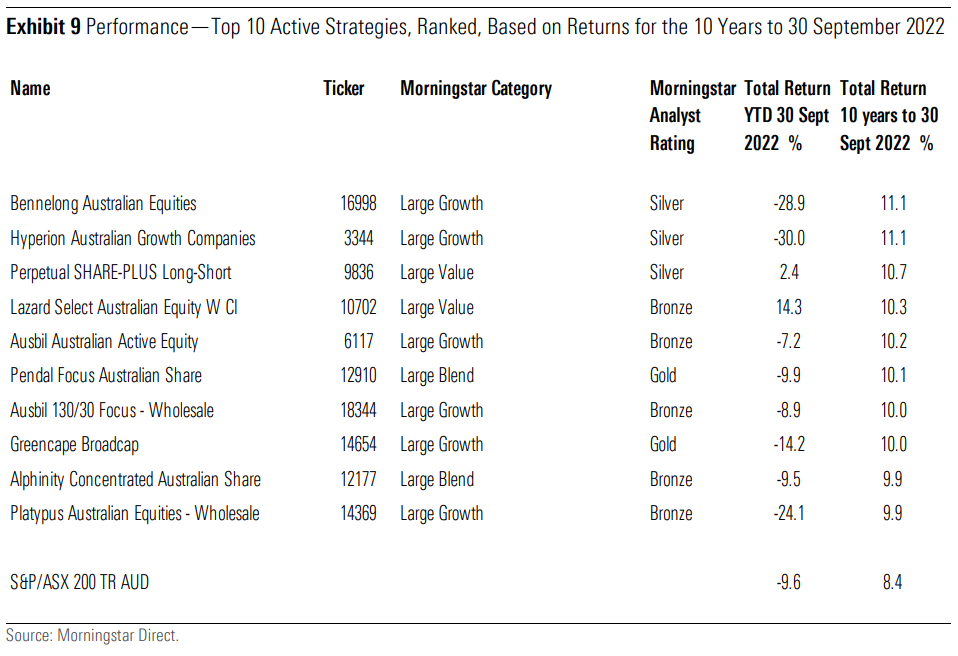
 Morningstar
Morningstar




